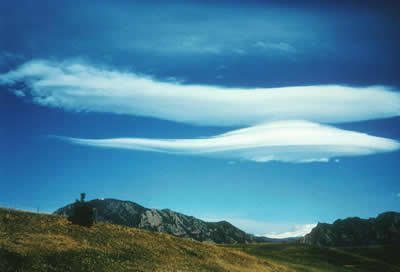Basically there are 3 kinds of up-winds that a glider is able to use, there are some more but they are either to close to the ground to or occur to rarely to be used by a glider.
- Thermal up-winds
inversion that stops the warm air from rising higher.Here often form cumuli that indicate that underneath them a up-wind is located.In these thermal up-winds it´s neccesary to fly narrow circles at a slow speed to stay in it.The climb-rate depends how good your plane, your up-wind and especcialy where you are flying.
Here in germany my best climb-rate was about 3m/s,but in tropical areas or deserts around the equator
your climbrate can reach about 5-6m/s.
- Ridge lift
- Wave lift
Ok now to my favourite, the wave lift.I´ve never tryed this but I will definitely have to check it out.
The powerfully rising and sinking air in mountain waves was discovered by glider pilot, Wolf Hirth, in 1933.Gliders can sometimes climb in these waves to great altitudes, although pilots must use supplementary oxygen to avoid hypoxia.
This lift is often marked by long, stationary lenticular (lens-shaped) clouds lying perpendicular to the wind.Mountain wave was used to set the current altitude record of 15,453 metres (50,699 ft) on 29 August 2006 over El Calafate, Argentina. The pilots, Steve Fossett and Einar Enevoldson, wore pressure suits. The current world distance record of 3,008 kilometres (1,869 mi) by Klaus Ohlmann (set on 21 January 2003)was also flown using mountain waves in South America.
This lift is often marked by long, stationary lenticular (lens-shaped) clouds lying perpendicular to the wind.Mountain wave was used to set the current altitude record of 15,453 metres (50,699 ft) on 29 August 2006 over El Calafate, Argentina. The pilots, Steve Fossett and Einar Enevoldson, wore pressure suits. The current world distance record of 3,008 kilometres (1,869 mi) by Klaus Ohlmann (set on 21 January 2003)was also flown using mountain waves in South America.
 |
| Thats a lenticular cloud it stays extremely steady |



Great post, it's nice to see that you study the science behind the photographs you take.
AntwortenLöschenLike Tipota said, I like how you merge science with photography. Really interesting.
AntwortenLöschenyou must have some real balls to do this soaring stuff!
AntwortenLöschenThat's what I always wanted to know .. really everyday I learn something new and that cloud what a lovely pic. Definitely followed.
AntwortenLöschenThere is always time to learn. Great pictures. Followed
AntwortenLöschenReally nice pictures and really informational, never would have learned this stuff otherwise, nice blog Followed.
AntwortenLöschenI would love to do something like gliding, being in the air and seeing everything from above just sounds amazing
AntwortenLöschenI remember learning about this stuff in the third grade. takes me way back.
AntwortenLöschenvery interesting :D awasome :D
AntwortenLöschenGood to know, thank you!
AntwortenLöschenGreat stuff! Makes me want to go out and glide in the sky for hours...
AntwortenLöschenwow this cloud is awesome
AntwortenLöscheni think i learned that in school... cant remember :/
AntwortenLöschenwow, that looks really, really nice. is photography just your hobby or are you a professional photographer?
AntwortenLöschenWow, that's cool.
AntwortenLöschenI thought that gliding is much easier
AntwortenLöschenOn my TODO list :)
AntwortenLöschenYay! Argentina shoutout there hahaha :D
AntwortenLöschenGotta say thats pretty cool but gliders scare the living crap out of me
That looks so amazing. I'm jealous. America is lame, we don't get to do cool things like that. This seems like it requires real skill, that's probably why American's don't attempt it; too damn lazy haha. I'd love to try.
AntwortenLöschensevenfoldsin.blogspot.com
I don't think I'd have the balls to try gliding... I bet the looks are astonishing though
AntwortenLöschenAnother great post
AntwortenLöschenThanks for the information
AntwortenLöschenNice info... that world record is CRAZY.
AntwortenLöschenI always learn so much from your blog posts man. Really cool!
AntwortenLöscheni want to fly like an eagle :) great post
AntwortenLöschenive always wanted to go out on a glider. this just makes me want to even more
AntwortenLöschenWao... Amazing post. I followed btw :)
AntwortenLöschenHow ironic you talk about gliders and the currents that keep them in the air. I just recently visited an airport close to my house and talked to a guy about professional gliding. It seems VERY interesting and this very post has furthermore sparked my interest in it. Thanks for this informaitonal and interesting post! +1
AntwortenLöschenGliding is awesome. I've done it before, figure I should get more into it.
AntwortenLöschenFollowed!
This was very informative for me. I don't know much about soaring but flying itself fascinates me and your posts gave me some basic knowledge on this topic. Maybe you want to share some personal experiences in the future!
AntwortenLöscheni'd love to give this a try sometime!
AntwortenLöschenThanks,i have a few DYI model gliders that i made.
AntwortenLöschenPeople can glide for ages using these techniques. nice info keep it up!
AntwortenLöschenVery cool. I have always wanted to try gliding. I will have to look into it sometime soon, and I'm sure this will help. Thanks.
AntwortenLöschenReally interesting stuff! I would love to go hangliding one day!
AntwortenLöschenFor sure on my list of things to do, we have a few places to try it out and get lessons here. Now I'm inspired to go try!
AntwortenLöschen